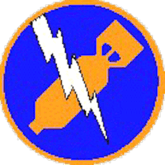370th Flight Test Squadron
The 370th Flight Test Squadron is a United States Air Force unit assigned to the 413th Flight Test Group, stationed at Edwards Air Force Base, California.
370th Flight Test Squadron
 | |
|---|---|
 KC-10, KC-46 and KC-135 in formation at Edwards AFB | |
| Active | 1942–1946; 1946–1965; 2001–present |
| Country | |
| Branch | |
| Role | Flight Testing |
| Part of | Air Force Reserve Command |
| Garrison/HQ | Edwards Air Force Base |
| Engagements | Southwest Pacific Theater Korean War[1] |
| Decorations | Distinguished Unit Citation Air Force Outstanding Unit Award Philippine Presidential Unit Citation Republic of Korea Presidential Unit Citation[1] |
| Insignia | |
| 370th Flight Test Squadron embloem (approved 19 June 2002)[1] |  |
| 370th Bombardment Squadron emblem (approved 27 March 1943)[1] |  |
Mission
The squadron is assigned to the United States Air Force Reserve and performs flight testing.
History
World War II
Formed as a heavy bombardment group in January 1942, trained in the Pacific Northwest under Second Air Force, with B-17 Flying Fortresses. Reassigned to Seventh Air Force in Hawaii, November 1942, performing search and rescue and antisubmarine patrols until January 1943 while transitioning to long-range B-24 Liberator heavy bombers.
Deployed to Central Pacific from Hawaii throughout 1943 for long-range combat bombardment operations against Japanese forces in the Central Pacific; New Guinea; Northern Solomon Islands and Eastern Mandates campaigns. Deployed to the New Hebrides in the South Pacific and operated from numerous temporary jungle airfields, engaging in long-range bombardment operations during the Bismarck Archipelago; Western Pacific; Leyte; Luzon and Southern Philippines campaigns until the end of the war in August 1945. Assigned to Clark Field, Philippines after the war ended, demobilized with personnel returning to the United States, unit inactivated as paper unit in January 1946 in California.
Strategic Air Command
Reactivated as Boeing B-29 Superfortress squadron at MacDill Field, Florida in August 1946 as part of Strategic Air Command. Was a training unit for antisubmarine warfare.[1]
Korean War
Deployed to Okinawa during the Korean War, carrying out combat operations over Korea throughout the conflict.[1] Remained in Okinawa until November 1954 when moved to the United States on paper.
Return to Strategic Air Command
Reformed at Lincoln Air Force Base, Nebraska, as a Boeing B-47 Stratojet medium jet bomber squadron, performed Operation Reflex deployments to North Africa until phaseout of B-47 in 1965 and inactivated.[1]
Flight Testing
Reactivated as a flight test squadron in 2001.[1]
Lineage
- Constituted as the 370th Bombardment Squadron (Heavy) on 28 January 1942
- Activated on 15 April 1942
- Redesignated 370th Bombardment Squadron, Heavy c. March 1944
- Inactivated on 18 January 1946
- Redesignated 370th Bombardment Squadron, Very Heavy on 15 July 1946
- Activated on 4 August 1946
- Redesignated 370th Bombardment Squadron, Medium on 28 May 1948
- Discontinued and inactivated, on 25 March 1965
- Redesignated 370th Flight Test Squadron on 24 September 2001
- Activated in the reserve on 1 October 2001[1]
Assignments
- 307th Bombardment Group, 15 April 1942 – 18 January 1946
- 307th Bombardment Group, 4 August 1946
- 307th Bombardment Wing, 16 June 1952 – 25 March 1965
- 413th Flight Test Group, 1 October 2003 – present[1]
Stations
|
|
Aircraft
- Boeing B-17 Flying Fortress, 1942
- Consolidated B-24 Liberator, 1942–1945
- Boeing B-29 Superfortress, 1946–1954
- Boeing B-47 Stratojet, 1955–1965[1]
- Beechcraft C-12 Huron, 2001–present
- General Dynamics F-16 Fighting Falcon, 2001–present
- McDonnell Douglas KC-10 Extender, 2001–present
- Boeing KC-135 Stratotanker 2001–present
References
- Notes
- Kane, Robert B. (29 June 2010). "Factsheet 370 Flight Test Squadron (AFRC)". Air Force Historical Research Agency. Retrieved 22 July 2017.
Bibliography
![]()
- Maurer, Maurer, ed. (1983) [1961]. Air Force Combat Units of World War II (PDF) (reprint ed.). Washington, DC: Office of Air Force History. ISBN 0-912799-02-1. LCCN 61060979. Retrieved 17 December 2016.
- Maurer, Maurer, ed. (1982) [1969]. Combat Squadrons of the Air Force, World War II (PDF) (reprint ed.). Washington, DC: Office of Air Force History. ISBN 0-405-12194-6. LCCN 70605402. OCLC 72556. Retrieved 17 December 2016.
- Ravenstein, Charles A. (1984). Air Force Combat Wings, Lineage & Honors Histories 1947–1977. Washington, DC: Office of Air Force History. ISBN 0-912799-12-9. Retrieved 17 December 2016.